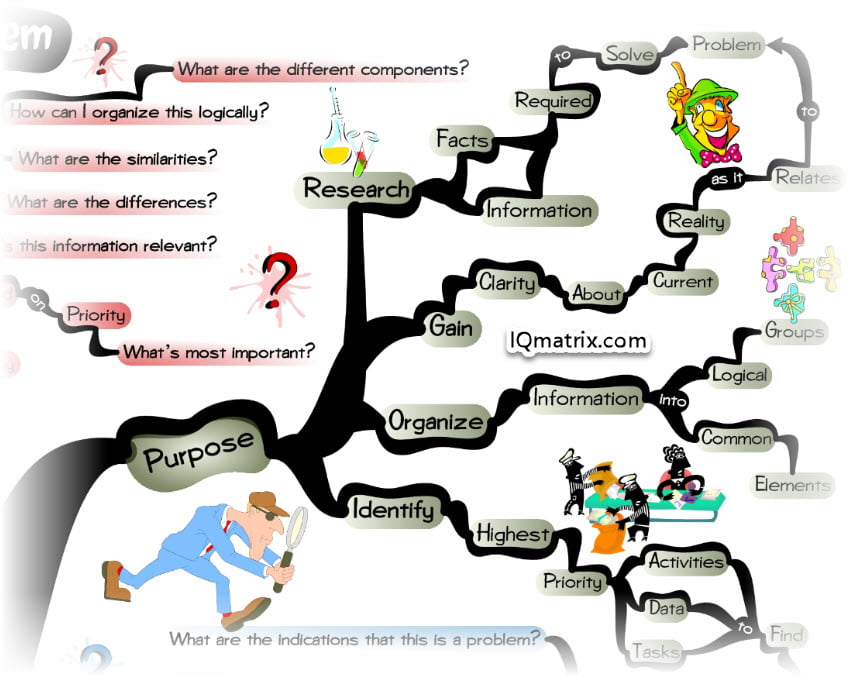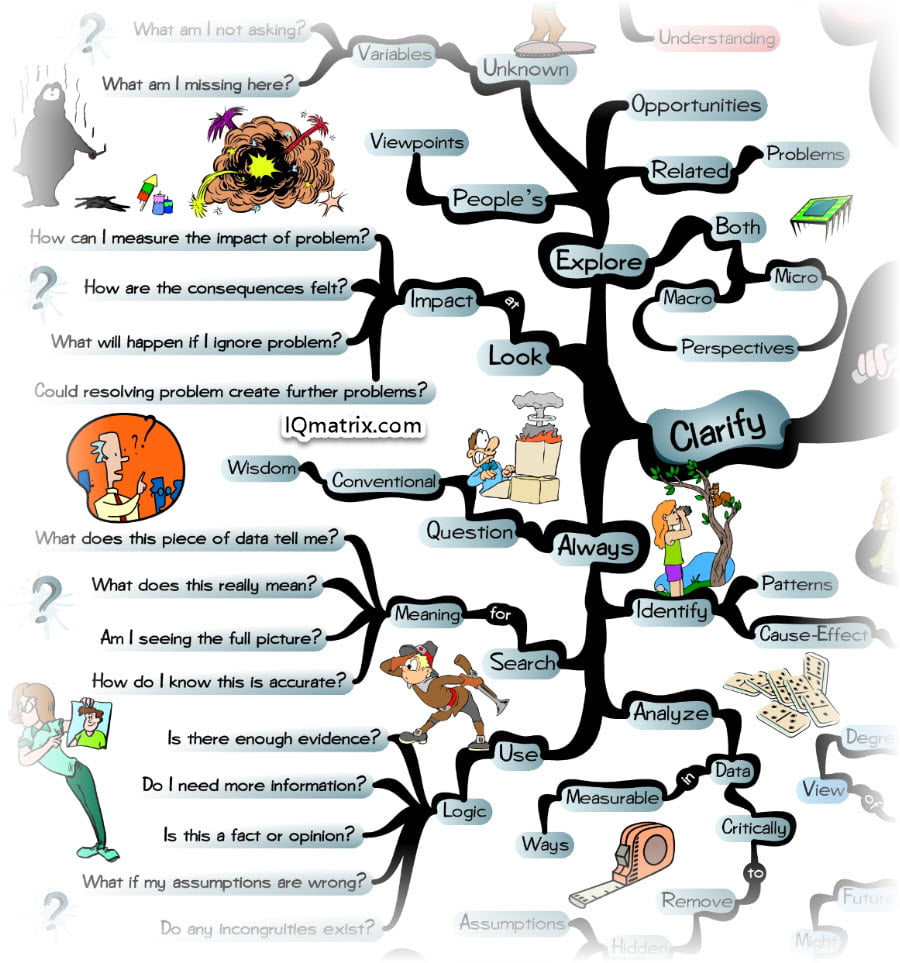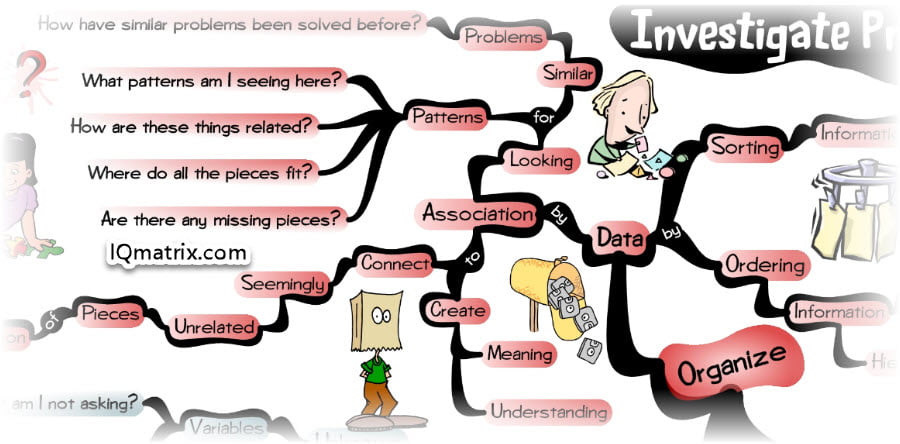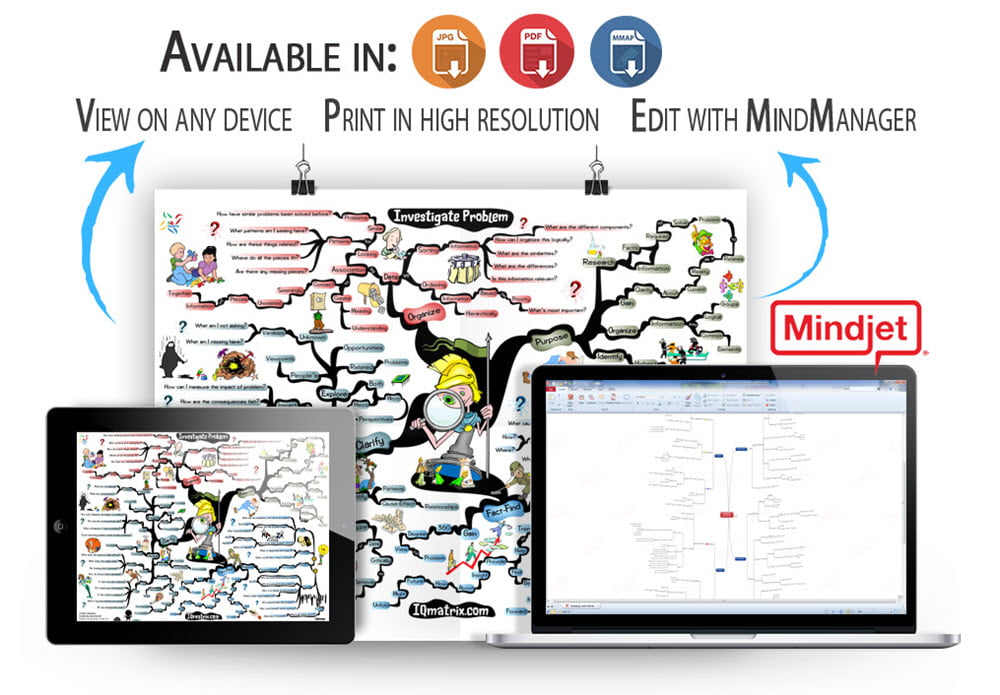Again and again, the impossible problem is solved when we see that the problem is only a tough decision waiting to be made. – Robert Schuller
This is the second of a five-part series of articles that explores the creative problem-solving process. Each article builds on the next; taking you through a series of steps to help you solve any life or business challenge you face. Here are links to all articles within this series:
- Define Your Problem
- Investigate Your Problem
- Re-Imagine Your Idea
- Engineer Plan of Action
- Execute and Master
As you read through these articles, it is highly recommended that you have a problem in mind that you can work with. This will help you to immediately put these ideas into practice. Only in this way will you gain optimal value from this process.
The Purpose of this Step
The purpose of this step is to gain more clarity about your current reality as it relates to the problem you are working on. To do this you will need to undertake some research and maybe a fact-finding mission to help you collate all the information you need to effectively solve this problem.
This process sounds pretty straightforward, however, it’s typically not the information you collect that helps you solve the problem, but rather the insights you gather from this research that makes all the difference. It will, therefore, be of paramount importance — moving through this step — that you are able to organize this information in a way that helps you make sense of the facts surrounding the problem.
Your Fact-Finding Mission
Your objective here is to launch a fact-finding mission to help you gather absolutely everything you can about your problem and about the circumstances surrounding this problem. You are essentially aiming to gain a 360-degree view of your problem; leaving no stone unturned.
This fact-finding mission is of course of tremendous value. Often we may typically try and solve a problem without knowing all the facts. Then, as a result, we make an assumption and jump to conclusions, which can often lead us astray.
In order to avoid these pitfalls, let’s explore the circumstances surrounding your problem by taking a look at four key areas:
- The origins of the problem.
- The “positives” surrounding the problem.
- Who is involved in the problem?
- How much control you have over this problem.
The Origin of the Problem
First of all, let’s consider the origin of the problem; exploring how it all initially started. Ask yourself:
What are the indications that this is a problem?
When specifically did this problem begin?
How specifically did this problem begin?
How often does this problem occur?
When did it specifically happen?
How did it specifically happen?
Where did it specifically happen?
When does it not happen?
While answering these questions we want to get very specific. We want to know exactly the why, how, when, and the where of the problem. The more information and facts we have about how the problem originally evolved, the better insights we can potentially piece together to help us solve the problem.
So for instance, if we are looking at our example problem of not being able to pay our bills at the end of this month, then it’s clear that this problem didn’t just arise out of thin air. In fact, the origins of this problem might have started years ago and only today are you feeling its effects.
Given this understanding, to solve this problem you must address it at its origin. For instance, this problem could effectively stem from poor financial choices you made years ago, or possibly through limiting financial habits you developed over a period of time. Now of course, as discussed within the very first part of this series there could also be psychological reasons why you are currently experiencing this problem. As such, it’s important to take this into consideration while conducting your research.
The Positives of the Problem
Let’s now take a look at the positive side of your problem. Ask yourself:
What are the positives of this problem?
What is happening that is actually good?
What would I like to have continue as is?
These might seem like strange questions. Problems are not typically good, right? However, there may very well be positive aspects of this problem that are of value.
Now, of course not all problems will have a noticeable silver lining; but unless you take this into consideration, then you’ll never really know. Using our example of not being able to pay your bills on time, you could say that the silver lining here is that it presents you with an opportunity to create a budget, to ask for a raise at work, to potentially consider changing your career path, or to begin building an emergency fund. All these options might not help you solve your current problem, however, they can certainly set you up for a future without this problem.
Alternatively what is good is that you already have a budget in place to help you better manage your money. However, possibly you may need to tweak this budget somewhat and potentially make some short-term sacrifices in order to pay these bills on time.
The People Involved in the Problem
Let’s now move on and take a look at the people involved in this problem. Ask yourself:
Who is involved in this problem? How are these people involved?
Who has been affected by this problem? How are they affected?
Who specifically is to blame for this problem?
Where does the responsibility lie?
Who specifically perpetuates this problem?
Who specifically could benefit from a solution to this problem?
You will of course typically be the person involved in this problem, affected by this problem, and maybe even to blame for this problem. However, there may also be other people in the mix. For instance, your family could be affected by this problem, your electricity company could be partly to blame for over-billing you in the last period, and your manager could very well be holding you back from getting that promotion at work that you so desperately want.
All the above-mentioned people/companies are involved in this problem in some way. The key for you moving forward will be to determine where the responsibility lies and what you can potentially do to influence each party to effectively resolve this problem.
Now of course, when it comes to responsibility it’s critical that no matter what, we take full responsibility for this problem. Yes, other people and companies may have wronged you, however, unless you take responsibility for your predicament, then you can never really hope to effectively resolve your problem. This, of course, means no complaining, making excuses or blaming. Just take responsibility for your problem and commit yourself towards resolving it successfully using your personal initiative and resourcefulness.
Your Level of Control Over Problem
Given all this, let’s now consider what your level of control is over this problem. Ask yourself:
Where do I have control?
Where do I have some kind of influence?
Where do I have absolutely no control?
You, for instance, have control over yourself and over the choices you make moving forward. You may not have control over the decisions your manager makes or over the electricity company’s bill, however you do have some influence in these instances. And your influence of course essentially comes down to your ability to persuade others to get the outcome you are after.
Then there will, of course, be things that you have absolutely no control over; and whatever those things are for you, just let them go. There is no point in stressing over things that you can do nothing about. Focus your energies instead on the things that you can control and influence. Over time your influence may very well grow but you initially need to take those first steps to get the ball rolling.
In the light of all this, it’s important to also take into consideration any patterns or trends you notice that can help you find the best possible path moving forward. These patterns or trends could very well provide you with insights about what your future might look like over the coming years.
For instance, let’s say you notice that you are mismanaging your finances. If you continue moving down this path, then it’s possible you could get into a massive amount of debt in the years ahead. Or maybe going over old electricity bills you notice that your power company is one of the most expensive in the market. Just maybe if you took the time to shop around you might be able to get a better deal that could save you hundreds of dollars over the course of a year. However, unless you physically spend time looking at these patterns/trends then you will never really know what opportunities might be going amiss.
Gain More Clarity About the Facts
Now that you have concluded your fact-finding mission, it’s time to gain a little more clarity about these facts in order to help you better understand the problem.
It’s important as you move through this stage of the process that you do not jump to conclusions or make assumptions about the problem, about the circumstances surrounding the problem, and/or about the people involved within the problem. In order to avoid these pitfalls, it’s critical that you think about the facts surrounding the problem in a logical way. For instance, ask yourself:
Is there enough evidence to support this?
Do I need more information?
Is this a fact or only an opinion?
What if my assumptions about this are completely false?
Do any incongruities exist?
To break this down even further, consider the meaning of the facts you have collected. Ask yourself:
What does this piece of data tell me?
What does it all really mean?
Am I seeing the full picture or only part of the picture?
How do I know this is accurate?
In order to get all your facts straight, it’s critical that you are open to the idea of questioning conventional wisdom. What makes sense may not be true at all. However, unless you are open to this possibility then you are likely to jump to unjust conclusions that may lead you astray.
In the light of all this, it’s also important that you explore related problems, potential opportunities that could arise from this problem, as well as various viewpoints. All of these areas can provide you with deeper insights and a better understanding of the problem you are dealing with.
For instance, a potential opportunity in the light of this problem could be that you decide to take a budgeting course; or maybe you commit yourself to changing your career path; or it might even force you to choose a different and more affordable electricity provider. All these are potential opportunities that you can take advantage of.
Finally, it’s also important to take into consideration the impact of this problem moving forward. Ask yourself:
How can I measure the impact of this problem?
How are the consequences of this problem felt?
What will happen if I ignore this problem altogether?
Could resolving this problem create even further problems down the line?
Not being able to pay off your bills by the end of this month might not be the end of the world, however, if you continue down this spiral then you could very well get yourself into a massive amount of debt in the years to come. It’s therefore helpful to consider the long-term impact of the problem and the possible consequences that may result if you refuse to deal with it in the present moment. Therefore, this problem could very well spore many more problems in the future. For instance, the stress of dealing with this problem could affect your health, or could potentially put a strain on your relationship. These are all very real possibilities. As such solving this problem today becomes of paramount importance.
Organize Your Data
The final step of this stage of the process involves organizing the data you have collected so that you are better able to understand what it all means.
For smaller problems this organization process might not be necessary, however for larger problems, — where you have collected a vast amount of facts and data — then this is something that can be worthwhile.
To begin organizing this data, ask yourself:
What patterns am I seeing here?
How are things related?
Where do all the pieces fit?
Are there any missing pieces?
The key here is to create associations by connecting seemingly unrelated pieces of information together in order to give you a better understanding of the people, events and the circumstances surrounding this problem.
From here your main objective is to sort this information in the most logical way possible to help you work through this problem most effectively. To do this, ask yourself:
How can I organize all of this in a logical way?
What are the various components that make up this problem?
What are the similarities? What facts have common elements?
What are the differences? What facts are unrelated?
Is this piece of information even relevant for helping me solving this problem?
The main reason why this step of the process is of value is that it effectively helps you prioritize how you will work through this problem moving forward. To help you in that regard, you may want to consider one final question, that is:
How have similar problems been solved before?
Whether you have solved these problems, or someone else has solved them successfully, matters little. What’s important is that you gain an understanding of what has worked and the process that was used to help you to better work through your own problem today.
This is of course not yet about coming up with a concrete solution to the problem, but rather about helping you to prioritize your efforts moving forward to effectively work through this problem; and I do hope that this guide has provided you with the necessary insights to do just that.
What’s Up Next?
Having successfully defined our problem within Stage 1 of this process, and now having conducted some research to get a better understanding of the problem, we are ready to move forward in a big way and launch head first into the creative problem-solving process.
The next stage (#3) is probably the most exciting and involving stage as we will dive deep into your creative imagination. We will specifically explore a variety of creative approaches to help you work through your problem most effectively.
Time to Assimilate these Concepts
Did you gain value from this article? Is it important that you know and understand this topic? Would you like to optimize how you think about this topic? Would you like a method for applying these ideas to your life?
If you answered yes to any of these questions, then I’m confident you will gain tremendous value from using the accompanying IQ Matrix for coaching or self-coaching purposes. This mind map provides you with a quick visual overview of the article you just read. The branches, interlinking ideas, and images model how the brain thinks and processes information. It’s kind of like implanting a thought into your brain – an upgrade of sorts that optimizes how you think about these concepts and ideas. 🙂
Recommended IQ Matrix Bundles
If you’re intrigued by the idea of using mind maps for self-improvement then I would like to invite you to become an IQ Matrix Member.
If you’re new to mind mapping or just want to check things out, then register for the Free 12 Month Membership Program. There you will gain access to over 90 mind maps, visual tools, and resources valued at over $500.
If, on the other hand, you want access to an ever-growing library of 100s of visual tools and resources, then check out our Premium Membership Packages. These packages provide you with the ultimate visual reference library for all your personal development needs.









